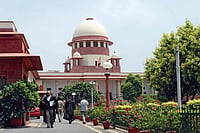Justice UU Lalit took oath as the 49th Chief Justice of India (CJI) on Saturday, succeeding NV Ramana who retired on Friday.
Earlier this month, former CJI Ramana recommended the name of Lalit as his successor, setting in motion the process of his appointment. As per convention, the present CJI is supposed to recommend the name of his successor to the Centre.
Lalit will have a tenure of less than three months as CJI. He will retire on November 8.
Who is Justice UU Lalit?
Justice UU Lalit was born on November 9, 1957. He practised as an advocate in the Bombay High Court from 1983 to 1985 before moving to Delhi. He was designated Senior Advocate by the Supreme Court in April 2004. Within a decade, he was appointed a Supreme Court judge on August 13, 2014.
Lalit is the second CJI who was directly elevated to the Supreme Court from the bar. Justice S M Sikri, who became the 13th CJI in January 1971, was the first lawyer to be elevated directly to the top court bench in March 1964.
As a lawyer, Lalit conducted the trial in 2G matters as a special public prosecutor for the Central Bureau of Investigation.
Highlights of Justice UU Lalit's SC tenure so far
Justice Lalit has been involved in a series of important and significant judgments in his tenure as an Supreme Court judge.
Triple Talaq: One of the most significant verdicts was the August 2017 judgment by a five-judge constitution bench which by a 3-2 majority ruled the practice of divorce through instant ‘triple talaq’ as “void”, “illegal” and “unconstitutional”. While then Chief Justice J S Khehar and Justice S Abdul Nazeer were in favour of putting on hold the judgment for six months and asking the government to come out with a law to that effect, Justices Kurian Joseph, R F Nariman, and UU Lalit held the practice as violative of the Constitution. Justices Khehar, Joseph, and Nariman have since retired.
Temple management rights: In another important judgment, a bench headed by Justice Lalit had ruled the erstwhile royal family of Travancore has the management right over the historic Sree Padmanabhaswamy Temple in Kerala, one of the richest shrines, holding that the rule of “heritability must get attached to a right of Shebait” (servitor) of the temple.
POCSO verdict: Overturning skin-to-skin POCSO judgment: Another landmark judgment by Justice Lalit was the quashing of a Bombay High Court verdict on a POCSO case in which the judge had ruled that only skin-to-skin contact could be considered sexual assault. A bench headed by Justice Lalit had later ruled that touching sexual parts of a child’s body or any act involving physical contact with ‘sexual intent’ amounts to ‘sexual assault’ under section 7 of the Protection of Children from Sexual Offences (POCSO) Act as the most important ingredient is sexual intent and not skin-to-skin contact.
Justice UU Lalit's vision as Chief Justice
Justice UU Lalit has set three priorities as the Chief Justice of India, according to Live Law.
1. More transparency in listing of cases in the Supreme Court
2. Bringing in a system for freely mentioning urgent matters before respective benches
3. Ensuring one Constitution Bench functions throughout the year
Justice UU Lalit is a third generation legal professional
Justice UU Lalit comes from a family that has been in the legal profession for over 100 years.
NDTV reported that Lalit grandfather was a lawyer and his father was a high court judge.
"His grandfather, Ranganath Lalit, was a lawyer in Solapur much before India's independence...His 90-year-old father, Umesh Ranganath Lalit, will be there. The veteran served as a high court judge after a long career as an advocate in his home state [of Maharashtra]," reported NDTV.
Justice UU Lalit to have just an 74-day tenure
Justice UU Lalit will only be the CJI for 74 days as he would retire on November 8.
Lalit will be the sixth CJI to have a tenure of less than 100 days.
Supreme Court judges retire on attaining the age of 65 while high court judges retire at 62.
Justice DY Chandrachud is the next senior-most judge in the Supreme Court after Lalit and is believed to be in line to be the CJI.
How CJI is appointed
According to the Memorandum of Procedure (MoP), which governs the process of appointment of judges in higher judiciary, the outgoing CJI initiates the process of naming the successor after getting a communication from the Law ministry.
The MoP says the senior-most judge of the apex court is considered fit to hold the office of the CJI and the views of the outgoing head of the judiciary have to be sought "at the appropriate time”.
The MoP, however, does not specify the time limit for the initiation of the process of recommending the name of the successor CJI.
(With inputs from PTI)


























